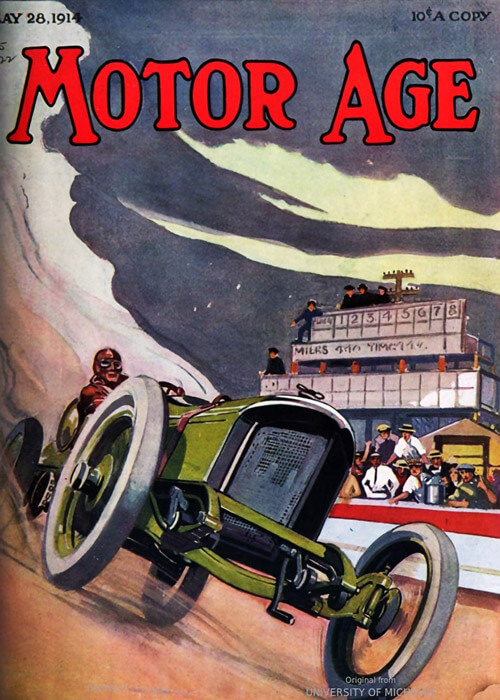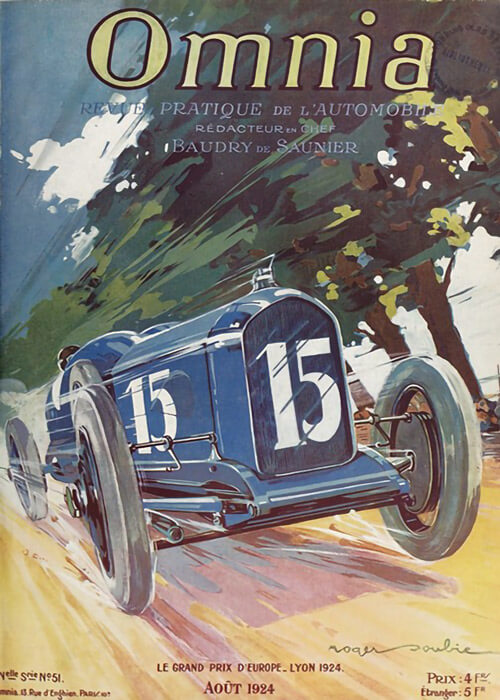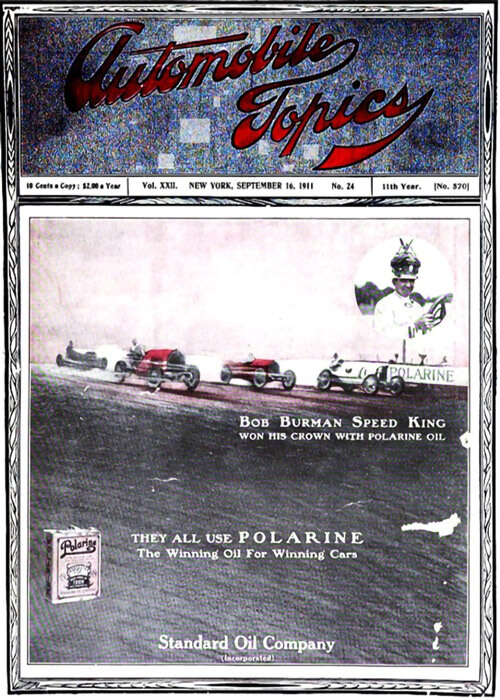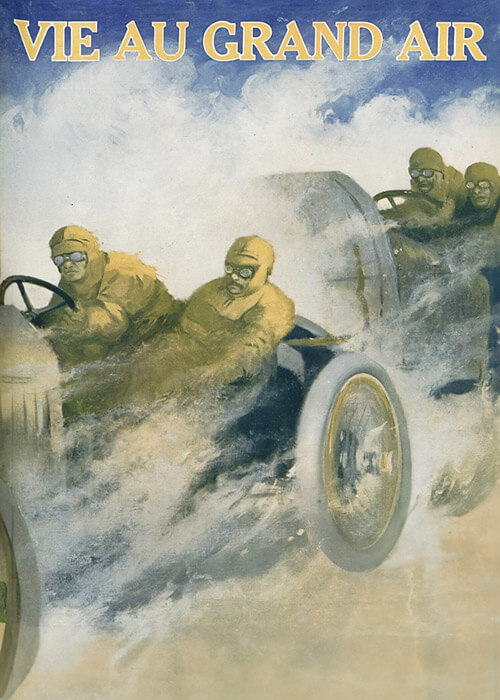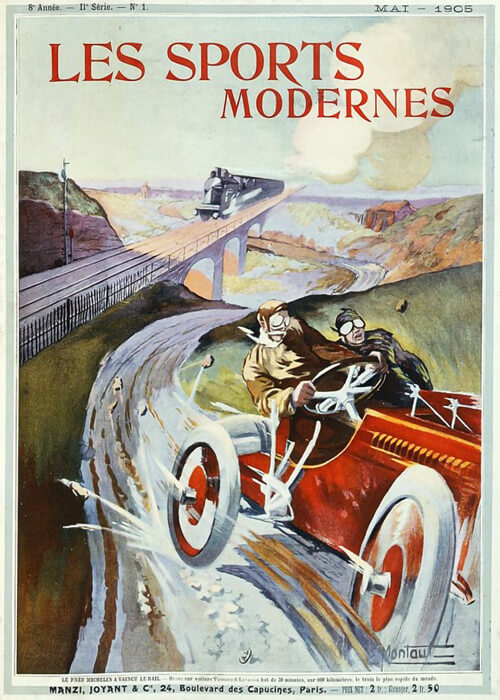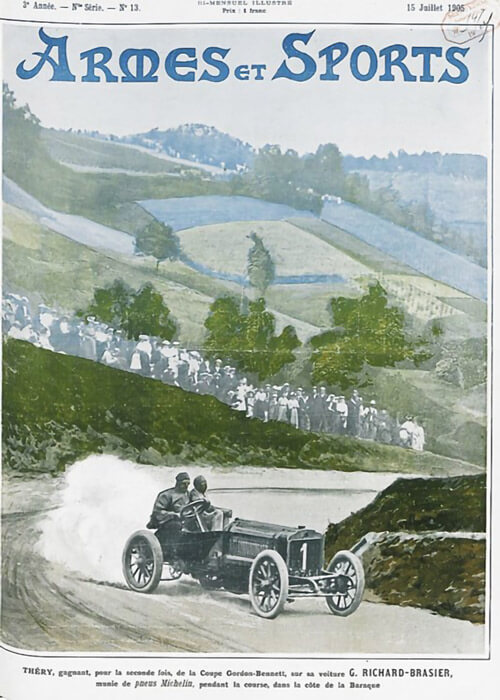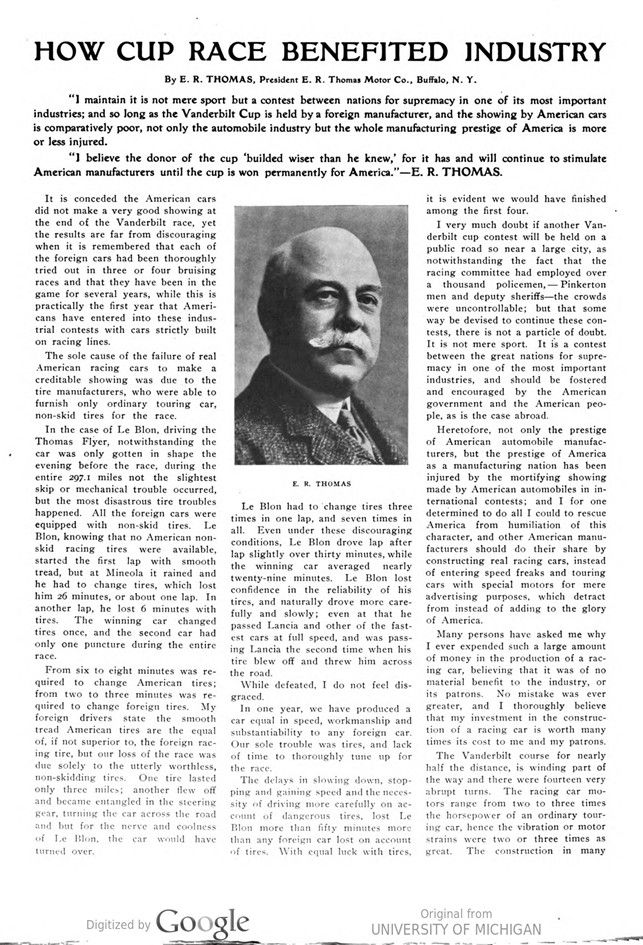
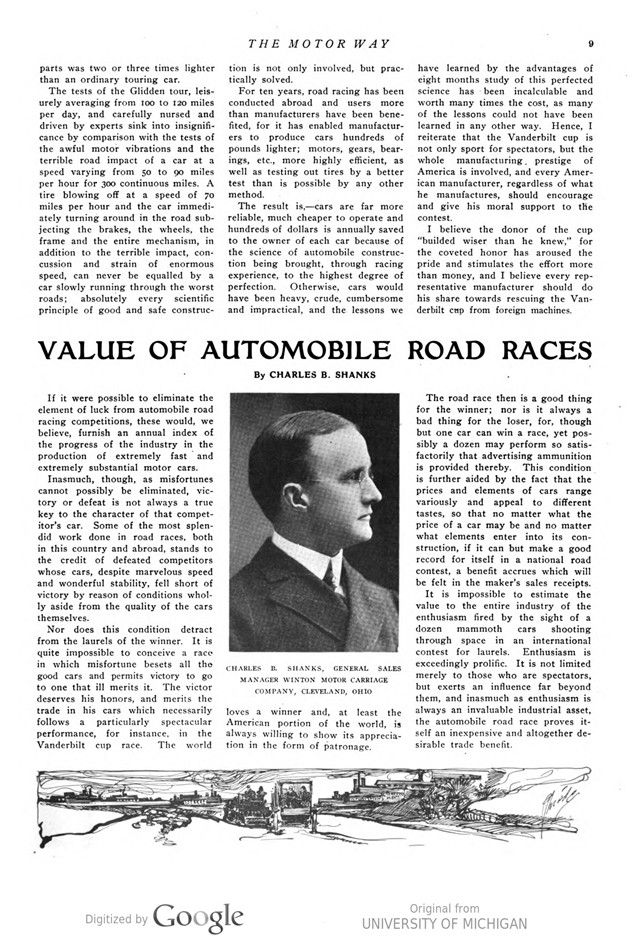
A view on automobile road races from E.R. Thomas, President of Thomas Motor Co., Buffalo, N.Y. Shortly after the 1906 Vanderbilt Cup race, discussion broke loose on racing and the American automobile industry.
Text and jpegs by courtesy of hathitrust.org www.hathitrust.org, compiled by motorracinghistory.com
THE MOTOR WAY Vol. XV, No. 14 October 4, 1906, page 9
HOW CUP RACE BENEFITED INDUSTRY
By E. R. THOMAS, President E. R. Thomas Motor Co., Buffalo, N. Y.
„I maintain it is not mere sport but a contest between nations for supremacy in one of its most important industries; and so long as the Vanderbilt Cup is held by a foreign manufacturer, and the showing by American cars is comparatively poor, not only the automobile industry but the whole manufacturing prestige of America is more or less injured.
„I believe the donor of the cup ‚builded wiser than he knew,‘ for it has and will continue to stimulate American manufacturers until the cup is won permanently for America.“ – E. R. THOMAS.
It is conceded the American cars did not make a very good showing at the end of the Vanderbilt race, yet the results are far from discouraging when it is remembered that each of the foreign cars had been thoroughly tried out in three or four „bruising races and that they have been in the game for several years, while this is practically the first year that Americans have entered into these industrial contests with cars strictly built on racing lines.
The sole cause of the failure of real American racing cars to make a creditable showing was due to the tire manufacturers, who were able to furnish only ordinary touring car, non-skid tires for the race.
In the case of Le Blon, driving the Thomas Flyer, notwithstanding the car was only gotten in shape the evening before the race, during the entire 297.1 miles not the slightest skip or mechanical trouble occurred, but the most disastrous tire troubles happened. All the foreign cars were equipped with non-skid tires. Le Blon, knowing that no American non-skid racing tires were available, started the first lap with smooth tread, but at Mineola it rained and he had to change tires, which lost him 26 minutes, or about one lap. In another lap, he lost 6 minutes with tires. The winning car changed tires once, and the second car had only one puncture during the entire race.
From six to eight minutes was re- quired to change American tires; from two to three minutes was required to change foreign tires. My foreign drivers state the smooth tread American tires are the equal of, if not superior to, the foreign racing tire, but our loss of the race was due solely to the utterly worthless, non-skidding tires. One tire lasted only three miles; another flew off and became entangled in the steering gear, turning the car across the road and but for the nerve and coolness of Le Blon, the car would have turned over.
Le Blon had to change tires three times in one lap, and seven times in all. Even under these discouraging conditions, Le Blon drove lap after lap slightly over thirty minutes, while the winning car averaged nearly twenty-nine minutes. Le Blon lost confidence in the reliability of his tires, and naturally drove more carefully and slowly; even at that he passed Lancia and other of the fastest cars at full speed, and was passing Lancia the second time when his tire blew off and threw him across the road.
While defeated, I do not feel disgraced.
In one year, we have produced a car equal in speed, workmanship and substantiability to any foreign car. Our sole trouble was tires, and lack of time to thoroughly tune up for the race.
The delays in slowing down, stopping and gaining speed and the necessity of driving more carefully on account of dangerous tires, lost Le Blon more than fifty minutes more than any foreign car lost on account of tires. With equal luck with tires, it is evident we would have finished among the first four.
I very much doubt if another Vanderbilt cup contest will be held on a public road so near a large city, as notwithstanding the fact that the racing committee had employed over a thousand policemen, – Pinkerton men and deputy sheriffs – the crowds were uncontrollable; but that some way be devised to continue these contests, there is not a particle of doubt. It is not mere sport. It is a contest between the great nations for supremacy in one of the most important industries and should be fostered and encouraged by the American government and the American people, as is the case abroad.
Heretofore, not only the prestige of American automobile manufacturers, but the prestige of America as a manufacturing nation has been injured by the mortifying showing made by American automobiles in international contests; and I for one determined to do all I could to rescue America from humiliation of this character, and other American manufacturers should do their share by constructing real racing cars, instead of entering speed freaks and touring cars with special motors for mere advertising purposes, which detract from instead of adding to the glory of America.
Many persons have asked me why I ever expended such a large amount of money in the production of a racing car, believing that it was of no material benefit to the industry, or its patrons. No mistake was ever greater, and I thoroughly believe that my investment in the construction of a racing car is worth many times its cost to me and my patrons.
The Vanderbilt course, for nearly half the distance, is winding part of the way and there were fourteen very abrupt turns. The racing car motors range from two to three times the horsepower of an ordinary touring car, hence the vibration or motor strains were two or three times as great. The construction in many parts was two or three times lighter than an ordinary touring car.
The tests of the Glidden tour, leisurely averaging from 100 to 120 miles per day, and carefully nursed and driven by experts sink into insignificance by comparison with the tests of the awful motor vibrations and the terrible road impact of a car at a speed varying from 50 to 90 miles per hour for 300 continuous miles. A tire blowing off at a speed of 70 miles per hour and the car immediately turning around in the road subjecting the brakes, the wheels, the frame and the entire mechanism, in addition to the terrible impact, concussion and strain of enormous speed, can never be equaled by a car slowly running through the worst roads; absolutely every scientific principle of good and safe construction is not only involved, but practically solved.
For ten years, road racing has been conducted abroad and users more than manufacturers have been benefited, for it has enabled manufacturers to produce cars hundreds of pounds lighter; motors, gears, bearings, etc., more highly efficient, as well as testing out tires by a better test than is possible by any other method.
The result is, cars are far more reliable, much cheaper to operate, and hundreds of dollars is annually saved to the owner of each car because of the science of automobile construction being brought, through racing experience, to the highest degree of perfection. Otherwise, cars would have been heavy, crude, cumbersome and impractical, and the lessons we have learned by the advantages of eight months’ study of this perfected science has been incalculable and worth many times the cost, as many of the lessons could not have been learned in any other way. Hence, I reiterate that the Vanderbilt cup is not only sport for spectators, but the whole manufacturing prestige of America is involved, and every American manufacturer, regardless of what he manufactures, should encourage and give his moral support to the contest.
I believe the donor of the cup „builded wiser than he knew,“ for the coveted honor has aroused the pride and stimulates the effort more than money, and I believe every representative manufacturer should do his share towards rescuing the Vanderbilt cup from foreign machines.
